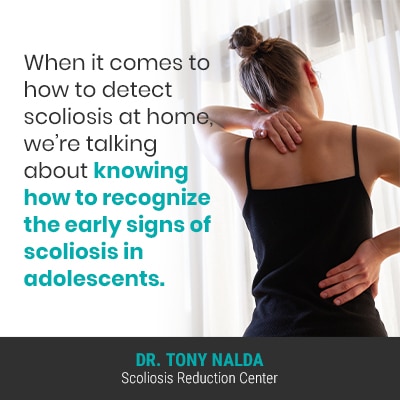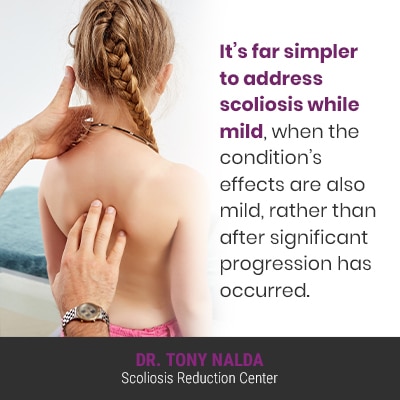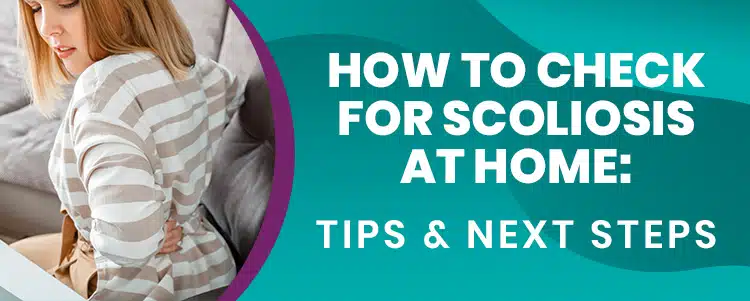While there are no treatment guarantees, as a progressive condition, the sooner treatment is started, the better. In the most prevalent type of scoliosis, adolescent idiopathic scoliosis, uneven shoulders and hips are early signs. If condition indicators are present, a professional diagnosis is needed, and then the most important decision needs to be made: how to treat it.
While scoliosis can’t be diagnosed at home, early signs can be checked for; knowing what to look for can help achieve early detection and early intervention, which increases chances of treatment success. The earliest sign of scoliosis is postural deviation.
As only a professional can diagnose scoliosis, let’s talk about how a diagnosis of scoliosis is reached.
Diagnosing Scoliosis
Scoliosis is a complex 3-dimensional spinal condition, and diagnosing it isn’t a simple process.
Scoliosis means an unnatural sideways spinal curve has developed, and the spine’s natural and healthy curves make it stronger, more flexible, and facilitate its even absorption of mechanical stress.
If an unnatural curve develops, it disrupts the biomechanics of the entire spine.
A scoliotic curve also rotates (twists), and in order to be considered a true scoliosis, the unnatural spinal curve has to be of a minimum size: Cobb angle measurement of at least 10 degrees.
A patient’s Cobb angle is determined during X-ray and involves a series of complex measurements that tells me how far out of alignment a scoliotic spine is.
When the spine’s healthy curves are in place, its vertebrae are aligned as they should be, but when one or more become tilted, their position changes and affects the structure of the spine itself.
The more tilted the vertebrae are at the apex of the curve, the higher the Cobb angle, and the more severe the condition:
- Mild scoliosis: Cobb angle measurement of between 10 and 25 degrees
- Moderate scoliosis: Cobb angle measurement of between 25 and 40 degrees
- Severe scoliosis: Cobb angle measurement of 40+ degrees
- Very-severe scoliosis: Cobb angle measurement of 80+ degrees
So as you can see, diagnosing scoliosis isn’t something a person can do themselves; it involves knowing how to measure scoliosis at home, plus having access to an X-ray, and knowing how to comprehensively interpret the results of a scoliosis X-ray is crucial when it comes to crafting customized treatment plans.
Before getting to the specifics of treatment, let’s talk about what can be learned by patients themselves at home.
How to Tell if You Have Scoliosis at Home
Scoliosis can’t be diagnosed at home; only a professional with years of experience and access to an X-ray machine can diagnose and further classify the highly-prevalent spinal condition.
What people can do, however, is educate themselves so they know the condition’s early and, often subtle, signs so early detection is possible.
In addition to scoliosis ranging widely in severity, there are also multiple condition types a person can develop.
Idiopathic scoliosis is the most common type to affect both adults and children, and adolescent idiopathic scoliosis (AIS) is the condition’s most common type overall, diagnosed between the ages of 10 and 18, so we’ll focus on how to check for early signs of adolescent idiopathic scoliosis.
Idiopathic means we don’t fully understand what causes the condition’s initial onset, but we most certainly know how to treat it, and we do understand what triggers its progression: growth and development.

When it comes to how to detect scoliosis at home, we’re talking about knowing how to recognize the early signs of scoliosis in adolescents.
Early Detection of Adolescent Idiopathic Scoliosis
While there are never treatment guarantees, diagnosing a condition early in its progressive line has many benefits, particularly when treating children who have not yet reached skeletal maturity, and this because of progression.
As a progressive condition, scoliosis has it in its nature to worsen over time, so even scoliosis diagnosed as mild can easily progress to become moderate, severe, or very severe, especially if left untreated, or not treated proactively.
As the trigger for scoliosis getting worse is growth, adolescents who are in, or are entering into, the stage of puberty are at risk for rapid-phase progression, due to the unpredictable and rapid growth spurts that characterize puberty.
A large focus of treatment for adolescent idiopathic scoliosis is on counteracting the condition’s progressive nature, despite the constant trigger of growth.
Scoliosis progressing means the unnatural spinal curve is increasing in size, the condition’s uneven forces are affecting the body more and more, and the spine is getting more rigid, making it less responsive to treatment.
In addition, it’s also the spine’s surrounding muscles and ligaments that play a role in maintaining the natural and healthy spinal curves by supporting and stabilizing the spine, and as scoliosis progresses, the spine’s surrounding muscles are also affected; a muscle imbalance is common in scoliosis as muscles on one side of the spine become stretched and loose from overuse, while muscles on the other side become weak from underuse.

It’s far simpler to address scoliosis while mild, when the condition’s effects are also mild, rather than after significant progression has occurred.
So what are the early signs of adolescent idiopathic scoliosis?
Early Signs of Adolescent Idiopathic Scoliosis
Scoliosis is a highly-variable condition, meaning no two patients will experience the exact same symptoms, which is why the very nature of scoliosis necessitates a customized treatment approach.
The way scoliosis affects a person is going to be shaped by a number of key patient/condition variables: patient age, curvature location, condition severity and type.
In most cases, the earliest telltale signs of scoliosis in adolescents are uneven shoulders and hips, and this is caused by the condition’s uneven forces disrupting the body’s overall symmetry.
Additional signs of scoliosis in adolescents can include:
- The head being uncentered over the torso
- Uneven shoulder blades with one protruding more than the other
- The development of a rib arch
- An uneven waistline
- Arms and legs that appear to hang at different lengths
These types of postural changes also involve changes to gait, balance, and coordination, not to mention clothing becoming ill-fitting.
As the leading spinal condition amongst school-aged children, there was a time when scoliosis screening was mandatory and performed by school nurses across the United States, but that has since changed, shifting the onus of early detection onto the shoulders of parents and adolescents themselves.
So knowing how to detect scoliosis at home means being aware of the condition’s subtle indicators, and if one or more is detected, this warrants the need for further testing performed by a professional so an official diagnosis can be reached.
Once a diagnosis is reached, this is when patients can really benefit from early detection, but only if a diagnosis is responded to with proactive treatment.
How to Treat Scoliosis Proactively
Early detection of adolescent idiopathic scoliosis is key because when responded to with proactive treatment, there are fewer limits to what can be achieved.
Being proactive means working to prevent further progression, escalating symptoms, and the need for more invasive treatment in the future; it’s far simpler to work towards not developing certain condition effects and complications, than trying to reverse them once they’ve developed.
Here at the Scoliosis Reduction Center®, I treat patients with a conservative chiropractic-centered treatment approach that impacts conditions on every level.
First and foremost, as a structural spinal condition, scoliosis has to be impacted on a structural level, and this can be achieved through condition-specific chiropractic care; a series of chiropractic techniques and manual adjustments can work towards repositioning the most-tilted vertebrae back into alignment with the rest of the spine.
Integrating multiple condition-specific treatment disciplines means patients of the Center experience the benefit of accessing different forms of treatment under one roof.
Physical therapy, when combined with chiropractic, can help by increasing core strength so the spine is optimally supported by its surrounding muscles, addressing any muscle imbalance, and improving brain-body communication.
Corrective bracing can be particularly effective on growing spines and can augment corrective treatment results by pushing the spine into a corrective position.
Once structural results have been achieved in the form of a curvature reduction, and the spine’s surrounding muscles have been strengthened, a series of custom-prescribed exercises can help patients establish a home-rehabilitation program to further stabilize the spine for sustainable long-term treatment results.
Conclusion
So the first step to reaching a diagnosis is awareness of how to check for scoliosis at home, but this is not the same as knowing how to diagnose scoliosis at home.
Diagnosing scoliosis is a complex process that involves a physical examination, an X-ray, taking a series of complex measurements, and knowing how to interpret those measurements to shape customized treatment plans around them.
Being able to check for the condition’s early signs at home can put patients on the path of early detection, intervention, and treatment success.
Early detection is particularly beneficial when treating children with scoliosis because having not yet reached skeletal maturity, they are at risk for progressing rapidly, and when it comes to adolescent idiopathic scoliosis, counteracting progression through growth is a key focus of treatment.
Starting treatment early means the spine is going to be at its most responsive, the condition’s effects are at their mildest, and the spine’s surrounding muscles are less likely to be unbalanced and strained.
Regardless of patient age or condition severity, the best time to start scoliosis treatment is as close to the time of diagnosis as possible, as this is when treatment success is going to be the most likely.




